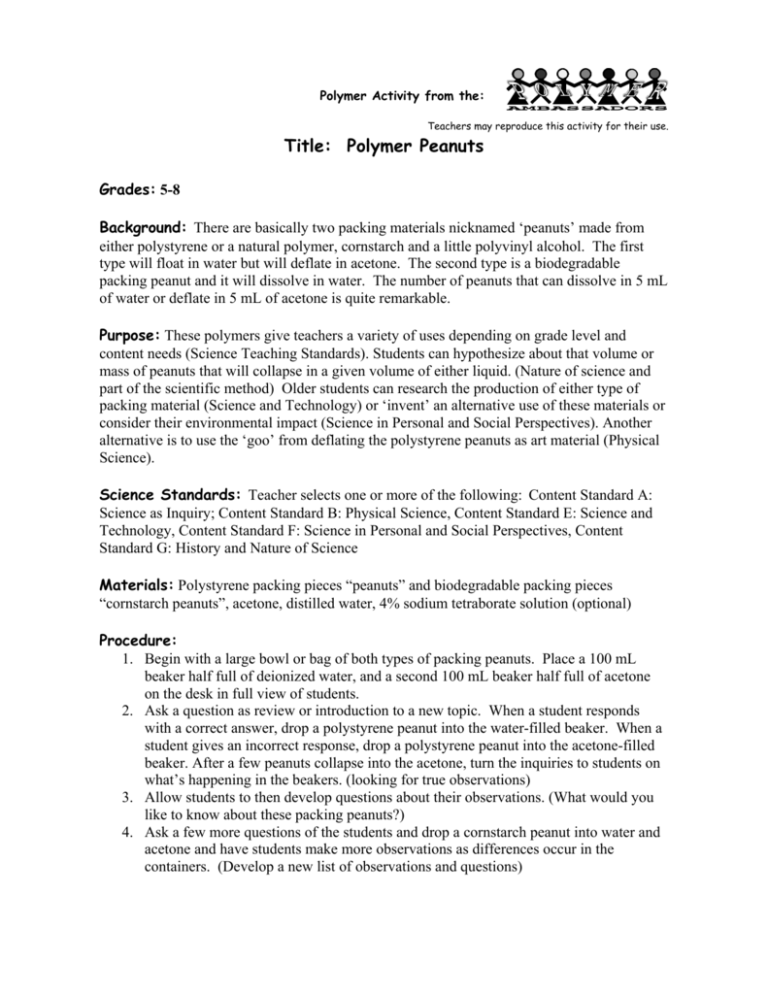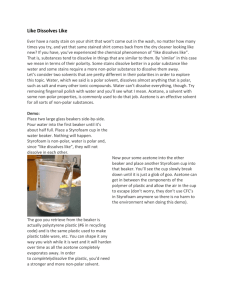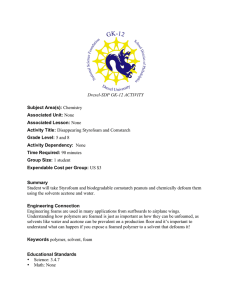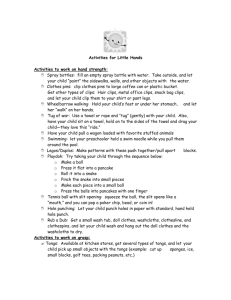Title: Polymer Peanuts
advertisement

Polymer Activity from the: Teachers may reproduce this activity for their use. Title: Polymer Peanuts Grades: 5-8 Background: There are basically two packing materials nicknamed ‘peanuts’ made from either polystyrene or a natural polymer, cornstarch and a little polyvinyl alcohol. The first type will float in water but will deflate in acetone. The second type is a biodegradable packing peanut and it will dissolve in water. The number of peanuts that can dissolve in 5 mL of water or deflate in 5 mL of acetone is quite remarkable. Purpose: These polymers give teachers a variety of uses depending on grade level and content needs (Science Teaching Standards). Students can hypothesize about that volume or mass of peanuts that will collapse in a given volume of either liquid. (Nature of science and part of the scientific method) Older students can research the production of either type of packing material (Science and Technology) or ‘invent’ an alternative use of these materials or consider their environmental impact (Science in Personal and Social Perspectives). Another alternative is to use the ‘goo’ from deflating the polystyrene peanuts as art material (Physical Science). Science Standards: Teacher selects one or more of the following: Content Standard A: Science as Inquiry; Content Standard B: Physical Science, Content Standard E: Science and Technology, Content Standard F: Science in Personal and Social Perspectives, Content Standard G: History and Nature of Science Materials: Polystyrene packing pieces “peanuts” and biodegradable packing pieces “cornstarch peanuts”, acetone, distilled water, 4% sodium tetraborate solution (optional) Procedure: 1. Begin with a large bowl or bag of both types of packing peanuts. Place a 100 mL beaker half full of deionized water, and a second 100 mL beaker half full of acetone on the desk in full view of students. 2. Ask a question as review or introduction to a new topic. When a student responds with a correct answer, drop a polystyrene peanut into the water-filled beaker. When a student gives an incorrect response, drop a polystyrene peanut into the acetone-filled beaker. After a few peanuts collapse into the acetone, turn the inquiries to students on what’s happening in the beakers. (looking for true observations) 3. Allow students to then develop questions about their observations. (What would you like to know about these packing peanuts?) 4. Ask a few more questions of the students and drop a cornstarch peanut into water and acetone and have students make more observations as differences occur in the containers. (Develop a new list of observations and questions) 5. The next step is up to the instructor, depending on the objectives of the demonstration. Explanation of the peanut’s content or structure or their guided research might follow. Vocabulary should include dissolve, collapse, and solution. 6. Development of a hypothesis and procedure for answering the question “How many peanuts will collapse in 5 mL of water (acetone)?” Attention to variables, controls, and methods of measurement (mass vs. volume) is important for middle school students. 7. If the collapsed polystyrene is removed from acetone with a wooden skewer and molded into a shape, then allowed to ‘dry out’ it will be very hard and rigid. The figure may then be painted. This also illustrates a physical change in pliability of the material. 8. When a maximum amount of cornstarch peanuts (also containing small amounts of the polymer PVA) have dissolved in the water, a few drops of a 4% solution of sodium tetraborate (borax) may cross link with the PVA to produce a slime material. (see the Polymer Ambassador website for more slime recipes) Conclusions: A creative teacher can extract wonderful discussions and lead students into scientific thinking with inexpensive and easily attainable materials. The most valuable lessons come from students’ hands-on and self generated inquiry. Written by DeAnn Campbell,Oklahoma Polymer Ambassador Copyright 2008






